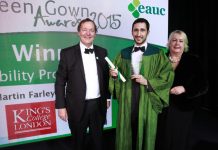The S-Lab: Supporting World Class Science programme aims to improve laboratory efficiency and effectiveness in all dimensions, including scientific value, resource efficiency and staff well-being. S-Lab director Peter James discusses the crucial role of estates and facilities in supporting these objectives.
S-Lab Conference discussions and surveys suggest that, despite recent progress, there is much scope to improve laboratory design and operation in HE without jeopardising – and often enhancing – safety and science.
The opportunities include more effective and efficient use of space and equipment, which is about specification, management, maintenance, training and other parameters as well as sharing; minimising consumption of chemicals, energy and water through measures that often have paybacks of only a few years; and optimising and recommissioning laboratory building services.
Taking these opportunities usually requires effective collaboration between those who work in laboratories and the support staff who provide and manage their equipment and infrastructure, including estates and facilities, procurement and research managers.
The annual S-Lab Awards have shown how some technical staff have used their on-the-ground experience to drive changes in areas such as freezer use and proper use of fume cupboards – for example Allison Hunter at King’s and Alaine Martin at Strathclyde. However, actions of these kinds are difficult without support from beyond the laboratory.
Mutual understanding needed
S-Lab Conference keynote Kim Toufectis of NASA – one of the world’s largest employers of engineers and scientists – believes that significant progress requires a service partner, rather than a tenant:landlord, relationship between laboratory users and estates/facilities. He says that this requires “a sense of common goals, and effective communication on how to achieve them”. He adds: “Both of these must be built on a mutual understanding of each other’s worlds. In short, the facilities function must learn to speak laboratory.”
A number of conference sessions will highlight how some UK universities are moving in this direction. One crucial intermediary is the building manager, who carries out many estates and facilities tasks, but within a laboratory context and is often employed by a faculty or research centre. Several HE estates departments with a large workload of new and refurbished laboratory projects have also recruited staff with laboratory experience as capital works or project managers.
Another emerging approach is a specific laboratory improvement role, based in estates but spending much of their time working with academics and technical staff to identify and realise cost-effective improvements in resource efficiency, equipment and space utilisation, and other measures. The business case for such appointment is supported by the experience of Salix Finance, which provides funding for energy efficiency measures and has found that many laboratory projects have paybacks well below its five year limit.
Martin Farley was the first such UK appointment at the University of Edinburgh, and now does the same job at King’s College. He instances replacement of energy inefficient drying cabinets and freezers, improved cold storage management and maintenance, LED replacement in microscopes, and shut the sash campaigns as activities that can be pushed forward by such roles.
Farley’s successor at Edinburgh, Andrew Arnott, is responsible for similar tasks, though now based in the Department for Social Responsibility and Sustainability, as is another full-time estates appointee, Rabbab Oun at the University of Strathclyde. The University of Bristol is also recruiting for a similar position and others are in the pipeline. The University of Cambridge has another variation, with two Building Energy Managers who focus on high-energy using buildings – most of which contain labs – and work with departments to reduce energy consumption and carbon emissions.
Lean laboratories
Much of the activity to date has been on energy and resource efficiency aided by the S-Lab assessment framework. This provides a tool to identify improvement opportunities in these areas – but the opportunities are much greater. They can also be about helping science by improving research outcomes and making scientists’ work easier as well as making laboratories leaner. To really capitalise on them, however, S-Lab surveys and experience suggest that a more joined up approach to maximising the efficiency and effectiveness of the science infrastructure is needed in universities.
Support functions that, in the words of Kim Toufectis, speak fluent “laboratory” are one side of this coin, and are changing to meet the challenge of laboratory modernisation. The other side of the coin, the need for more academic managers who can speak the language of science infrastructure and laboratory service partnerships, is not as bright. Only when this is met are we likely to see the integrated, strategic, sector and university initiatives that are needed to grasp the opportunities for more effective and efficient laboratories.
Peter James is director of the HEFCE-supported S-Lab: Supporting World Class Science initiative. The S-Lab Conference is being held at the University of Leeds on September 16-17 and has 90 parallel sessions, including a complete stream on Diamond/Wakeham issues in laboratories. Free tickets can be provided for sector managers interested in attending.






